The History of Thailand is rich and fascinating. It is full of ancient kingdoms, warlords, and Siamese Kingdoms that have come and gone over the millennia. The city of Bangkok is the modern heart of Thailand with a thriving nightlife, modern shopping malls, high-rise buildings & Thai Street Food. Despite this modern addition to the country’s history, there is also a wealth of ancient temples, fortresses, and ruins nestled in the more rural regions that showcase the ancient traditions of Thailand’s royalty.
Regardless of where you plan to visit in Thailand for its history and heritage, there are several great places that tell an interesting story about Siam’s past. From the different periods in Thai history, There are many armies have lost their lives fighting for control over the central Thai plains. Beyond all these historical sites though lies a much greater purpose - to revere Buddha as the Supreme Being in all aspects of life with meditation grounds at every corner. Today we list some of the best places to visit in Bangkok for its history and heritage.
Top 10 Places to Visit in Bangkok for the History and Heritage:
01. Wat Doi Ngam Mueang:
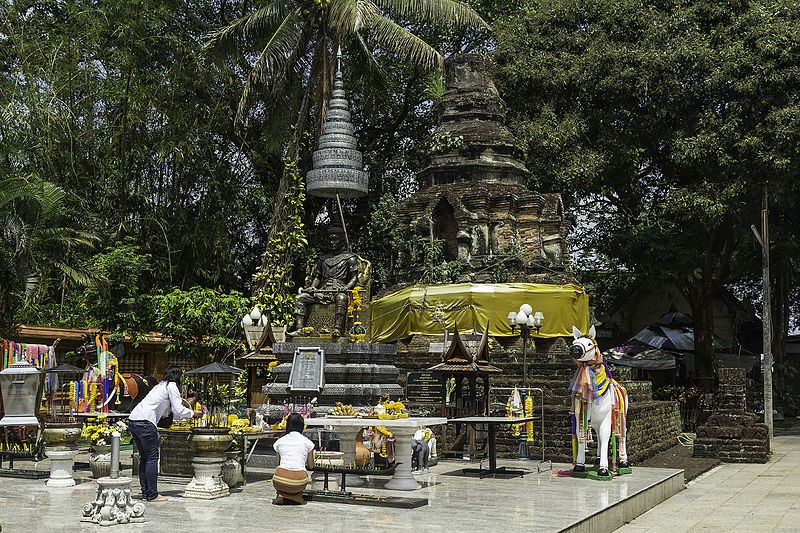
Wat Doi Ngam Mueang is a serene and beautiful temple located in the mountains of northern Thailand, known for its peaceful atmosphere and breathtaking panoramic views. The temple is a hidden gem for those seeking tranquility, offering both a spiritual escape and a chance to connect with nature. It combines elements of traditional Thai architecture with the surrounding lush greenery and misty mountains. Visitors often come here to meditate, take in the scenery, and explore its rich cultural heritage.
Visiting hours: Daily, from 8:00 AM to 5:00 PM.
Highlights:
- Scenic Location: Situated on a hill, the temple offers panoramic views of the surrounding area, providing a serene environment for meditation and reflection.
- Architectural Features: The temple is accessible via a long staircase flanked with naga-balustrades, leading to a double wooden gate adorned with elaborate carvings depicting scenes from Buddhism.
- Cultural Significance: Wat Doi Ngam Mueang is a symbol of the city's rich cultural heritage and serves as an important site for local festivals and ceremonies.
02. The Grand Palace:
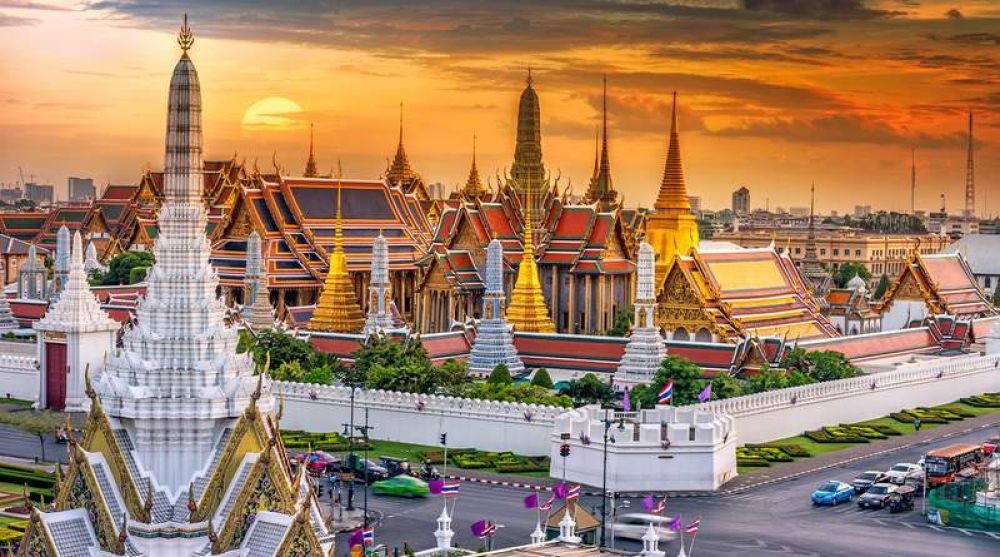
The Grand Palace is the most important royal residence in Bangkok and is the main residence of the Thai monarch. Built in 1782 by Rama I, the palace has undergone many renovations and expansions since then. The most important renovation during the reign of Rama the Second was the construction of the Grand Palace Plaza, the Chakri Memorial and the Golden Mount. However, the palace itself is well worth a visit, with a wide range of temples, Buddhist and Hindu shrines, and famous royal buildings. The most important and famous parts of the palace are the Emerald Buddha shrine, the Ratchadamnoen Avenue and the Chitrachathamsavali water show. Another interesting part of the palace is the collection of Thai costumes, which is one of the best globally. These costumes date back over 200 years. You can see them only in the collection of the palace.
Visiting Hours: The Grand Palace is open to visitors daily from 8:30 AM to 3:30 PM. It's advisable to arrive early to fully appreciate the site's beauty and to avoid the midday crowds.
Highlights:
- Temple of the Emerald Buddha (Wat Phra Kaew): Located within the Grand Palace complex, this temple houses the revered Emerald Buddha, a significant religious artifact in Thailand.
- Outer Court: This area was historically the administrative center of the kingdom and now includes the Temple of the Emerald Buddha.
- Inner Court: Reserved for the royal family, this section is not open to the public.
- Museum: The Grand Palace also features a museum showcasing artifacts and exhibits related to Thai history and culture.
Dress Code: As the Grand Palace is a sacred site, visitors are required to dress modestly. Both men and women should cover their shoulders and knees. Sleeveless tops, shorts, and skirts above the knee are not permitted. It's recommended to wear long pants and a shirt with sleeves.
Admission Fee: The entrance fee for foreign visitors is 500 Thai Baht, which includes access to the Grand Palace, the Temple of the Emerald Buddha, and the Queen Sirikit Museum of Textiles.
Location: The Grand Palace is situated on Na Phra Lan Road, near the Chao Phraya River in Bangkok. It's easily accessible by public transportation, including the Chao Phraya Express Boat and the Chao Phraya Tourist Boat.
03. Wat Phra Kaew:
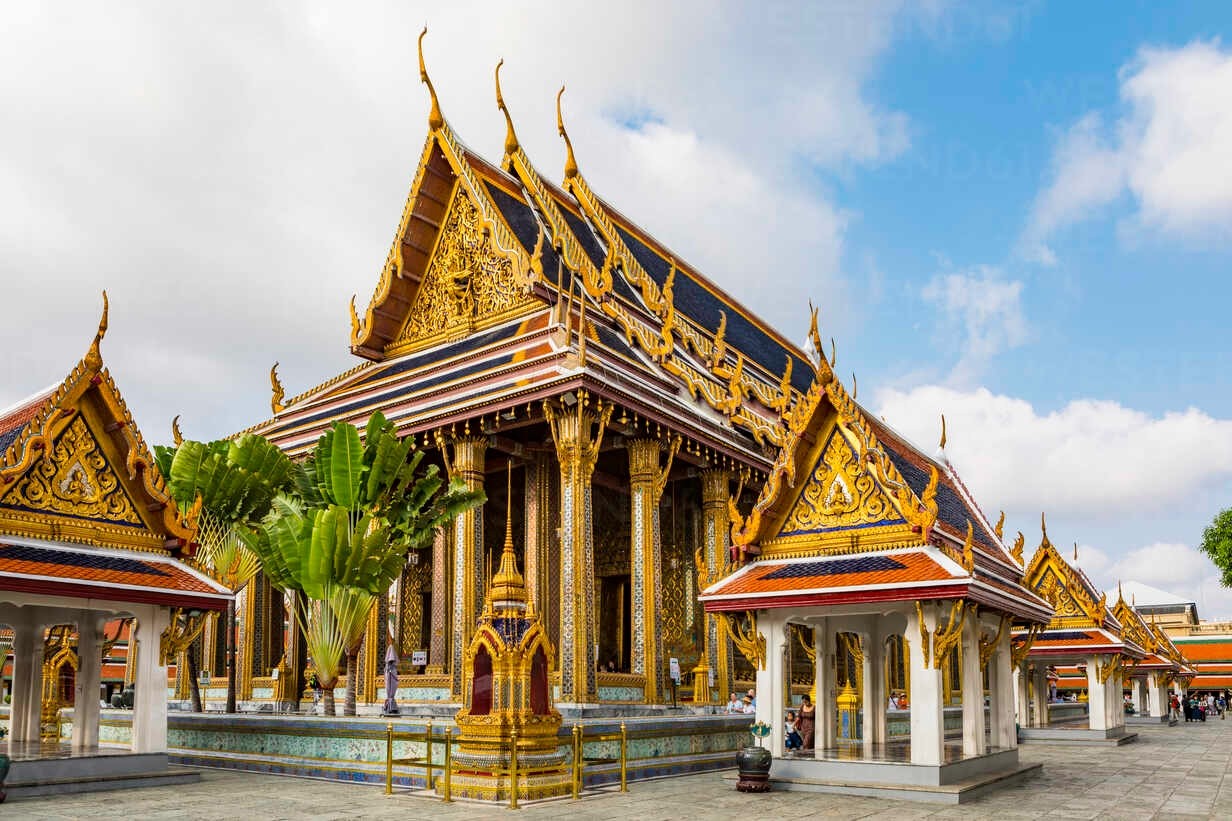
The Wat Phra Kaew temple is a historic old palace in Bangkok, Thailand. It houses the Emerald Buddha, an important Buddha image in Thailand. Located inside the walls of the old city, in the Sri Ayutthaya district the temple is now a UNESCO World Heritage Site. The Wat Phra Kaew is the most important Buddhist temple in Thailand, and one of the most important Buddhist temples in the world. The main image of the Buddha in the temple is the Emerald Buddha, an important image of the Buddha in Thailand. The Emerald Buddha shrine is also famous for a large collection of Buddhist statues. The interior of the temple is quite impressive, with walls painted with colourful murals depicting various Buddhist stories.
Visiting Hours: The temple is open daily from 8:30 AM to 3:30 PM. It's advisable to arrive early to fully appreciate the site's beauty and to avoid the midday crowds.
Highlights:
- Emerald Buddha: The temple enshrines the Emerald Buddha, a highly revered statue believed to bring prosperity and good fortune to Thailand. The statue is made of jade or jasper, not emerald, and is approximately 66 cm tall. It is dressed in gold attire, which is changed three times a year by the king to mark the changing seasons.
- Architecture: The temple complex showcases traditional Thai architecture, featuring intricate designs, golden spires, and detailed murals depicting scenes from Thai history and mythology. Notable structures include the Ubosot (ordination hall), the Phra Mondop (library), and the Phra Si Ratana Chedi (golden stupa).
- Murals: A gallery of mural paintings encircles the temple complex, depicting scenes from the Ramakian epic, Thailand's national epic.
Dress Code: As a sacred site, visitors are required to dress modestly. Both men and women should cover their shoulders and knees. Sleeveless tops, shorts, and skirts above the knee are not permitted. It's recommended to wear long pants and a shirt with sleeves.
Admission Fee: The entrance fee for foreign visitors is 500 Thai Baht, which includes access to the Grand Palace, the Temple of the Emerald Buddha, and the Queen Sirikit Museum of Textiles.
Location: Wat Phra Kaew is situated on Na Phra Lan Road, near the Chao Phraya River in Bangkok. It's easily accessible by public transportation, including the Chao Phraya Express Boat and the Chao Phraya Tourist Boat.
04. Bangkok’s Old City:
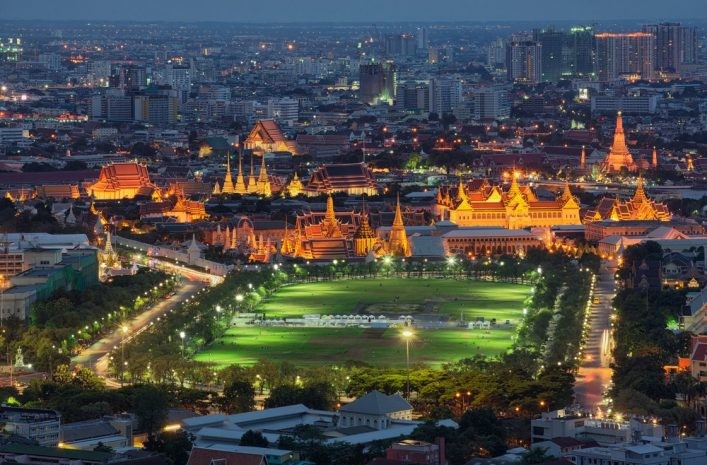
The Old City of Bangkok is a UNESCO World Heritage Site and is the oldest part of the city. The buildings here came into being during the Ayutthaya period between 1350 and 1767. UNESCO added the area, together with the Chinatown, to the List of World Heritage Sites in 1993. Due to the unusual and distinct architecture of the buildings, the old city is also known as Bangkok’s Chinatown. The most important site in the old city is the Grand Palace, from where the monarchy is still in charge.
Key Attractions:
- Grand Palace: A must-visit tourist attraction in Bangkok Old Town, the former royal residence with over 100 luxurious buildings, beautiful courtyards, and neatly kept gardens, built by King Rama I in 1782 in the heart of the old city of Bangkok, on the bank of the Chao Phraya River.
- Wat Phra Kaew (Temple of the Emerald Buddha): Located within the Grand Palace complex, this temple houses the revered Emerald Buddha, a symbol of Thailand's spiritual heritage.
- Wat Pho (Temple of the Reclining Buddha): Home to a massive reclining Buddha statue and renowned for its traditional Thai massage school.
- Wat Arun (Temple of Dawn): Situated across the river from the Grand Palace, this temple is famous for its stunning riverside location and intricate design.
- Chinatown (Yaowarat): A bustling area known for its vibrant street food scene, markets, and gold shops.
- Khao San Road: A lively street popular among backpackers, offering a mix of street food, bars, and shops.
Cultural Significance:
Rattanakosin reflects traditional Thai concepts of urban planning and architecture, with its layout centered around the Grand Palace, symbolizing the epitome of Thai sovereignty and grandeur.
Visiting Tips:
- Dress Code: When visiting temples, dress modestly by covering shoulders and knees.
- Transportation: The area is accessible via public transportation, including the Chao Phraya Express Boat and the Chao Phraya Tourist Boat.
- Best Time to Visit: Early morning or late afternoon to avoid crowds and the midday heat.
05. The Emerald Buddha Shrine:
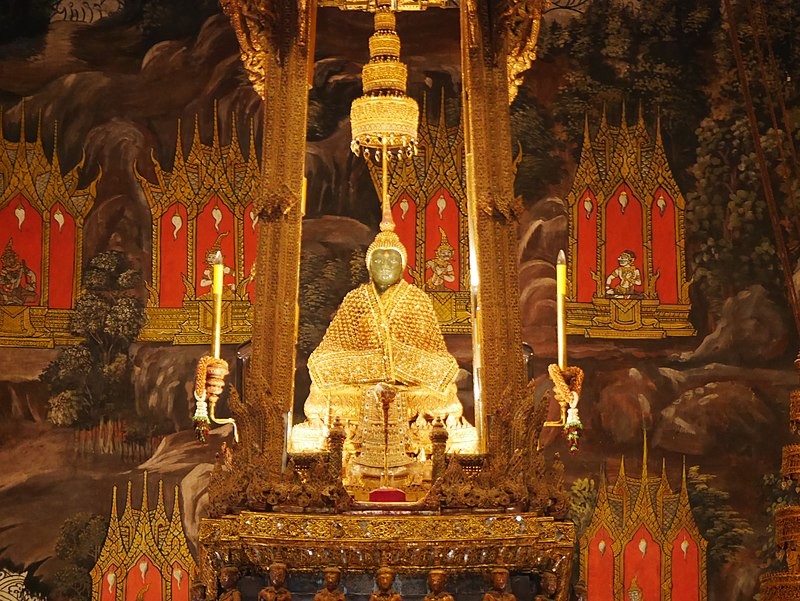
The Emerald Buddha Shrine is the most important Buddhist shrine in Bangkok. It is located on the Chao Phraya River, close to the Grand Palace. The shrine is one of the most important Buddhist shrines in Thailand. It is also one of the most sacred Buddhist shrines in the world. King Nhan Tham first commissioned the shrine after it was built in the 16th century. King Rama I completed the shrine in 1517. The shrine has been repaired and renovated several times, and features a large golden image of the Buddha. The shrine is also famous for the Tham Glan Dan, a large golden bowl adorned with jewels and rubies.
Historical Background: The Emerald Buddha was originally housed in a temple in Chiang Rai, Northern Thailand. In 1436, it was moved to Chiang Mai and later to Luang Prabang in Laos. In 1778, King Taksin brought the statue back to Thailand, and it was eventually enshrined in the newly constructed Wat Phra Kaew in 1784.
Visiting Information:
- Location: Wat Phra Kaew is situated within the Grand Palace complex in Bangkok.
- Visiting Hours: The temple is open daily from 8:30 AM to 3:30 PM.
- Dress Code: Visitors are required to dress modestly, covering shoulders and knees.
- Admission Fee: The entrance fee for foreign visitors is 500 Thai Baht, which includes access to the Grand Palace, the Temple of the Emerald Buddha, and the Queen Sirikit Museum of Textiles.
06. Suan Dusita Rajaramangala Bodhi-Viharaya:
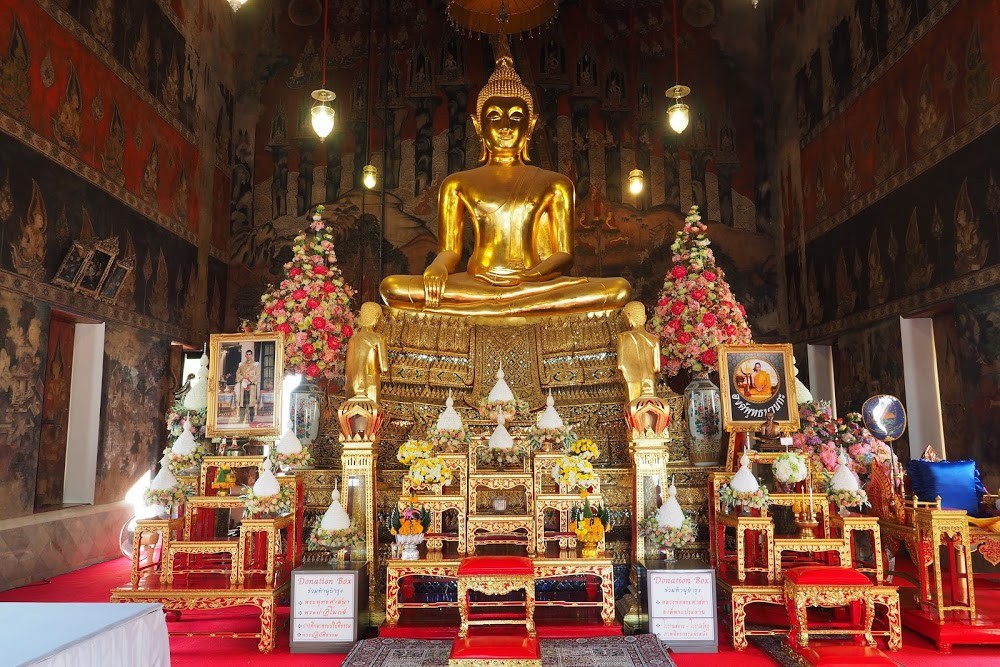
The Suan Dusita Rajaramangala Bodhi-Viharaya is a Buddhist monastery built in the 10th century. King Ramkhamhaeng, a famous scholar and King of the Lanna Kingdom, built the monastery. The monastery is one of the most important Buddhist shrines in the world, and is also one of the most sacred Buddhist shrines. The monastery located in central Bangkok, is close to the Grand Palace and the Royal Plaza. The main gate of the monastery, decorated with images of the 12 apostles, serves as the main entrance to the sanctuary. The main shrine of the monastery is the most important shrine in Thailand, and houses one of the largest Buddha images in the world. The shrine is also famous for the Tham Maung Po, a large gold Buddha statue that was built in the 16th century.
Key Features:
- Bodhi Tree: The temple enshrines a Bodhi tree, symbolizing the path to enlightenment. This tree is a sapling from the original Sri Maha Bodhi, which is considered the oldest recorded tree in the world.
- Architecture: The temple complex features traditional Thai architectural elements, including ornate decorations, statues, and serene surroundings conducive to meditation and reflection.
Visiting Information:
- Location: Suan Dusita Rajaramangala Bodhi-Viharaya is situated in the Suan Dusit area of Bangkok.
- Visiting Hours: The temple is generally open to visitors during daylight hours. It's advisable to check the specific visiting hours before planning your visit.
- Dress Code: As with most Buddhist temples, visitors are expected to dress modestly. This typically means covering shoulders and knees.
- Admission Fee: There is usually no admission fee to visit the temple, but donations are welcome to support its maintenance and activities.
Cultural Significance:
The Suan Dusita Rajaramangala Bodhi-Viharaya serves as a center for meditation, religious ceremonies, and community gatherings. The presence of the Bodhi tree enhances its spiritual significance, attracting both locals and tourists seeking a tranquil environment for reflection and prayer.
07. Chinatown (Yaowarat):
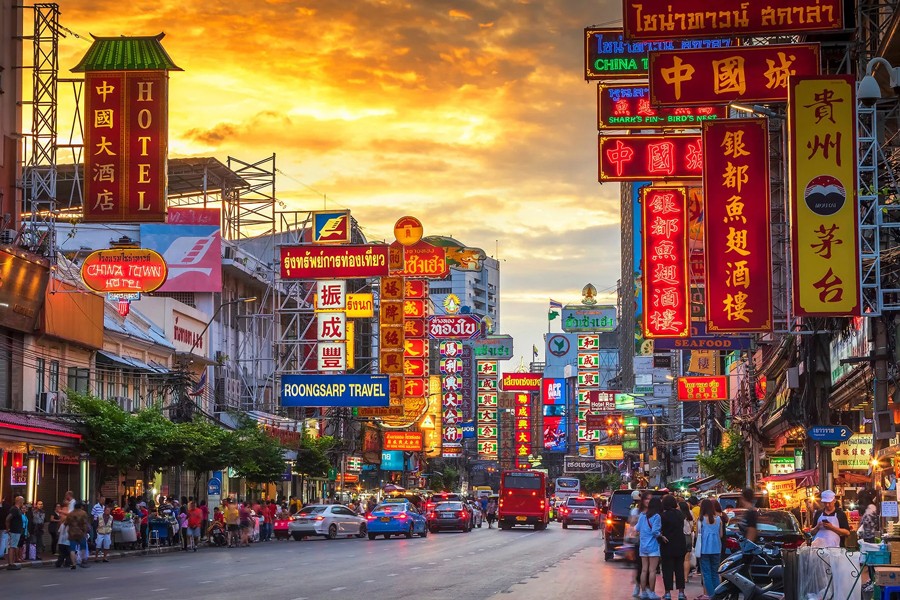
Yaowarat, commonly known as Bangkok's Chinatown, is a vibrant district that offers a rich tapestry of culture, history, and culinary delights. Established in 1782, Yaowarat is one of the oldest and most bustling neighborhoods in Bangkok, renowned for its lively streets, traditional Chinese architecture, and a myriad of shops and eateries.
Key Highlights:
- Yaowarat Road: The main artery of Chinatown, Yaowarat Road, is lined with gold shops, Chinese herbal medicine stores, and street vendors. By day, it bustles with activity, and by night, it transforms into a gastronomic haven, offering some of the best street food in the city.
- Wat Traimit (Temple of the Golden Buddha): Home to the world's largest solid gold Buddha statue, weighing 5.5 tons and standing 3 meters tall, this temple is a significant cultural and historical landmark.
- Wat Mangkon Kamalawat: As the largest and most important Chinese temple in Bangkok, Wat Mangkon Kamalawat is a center for Chinese-Thai religious practices. During festivals like Chinese New Year, the temple becomes a focal point for celebrations.
- Street Food: Yaowarat is famed for its street food scene, offering a diverse array of dishes such as dim sum, noodles, and traditional Chinese desserts. The area is especially lively in the evenings, with numerous food stalls and restaurants serving delectable treats.
- Chinese Heritage Centre: This museum provides insights into the history and contributions of the Chinese community in Bangkok, showcasing artifacts and exhibits that narrate their rich cultural heritage.
Visiting Tips:
- Best Time to Visit: While Yaowarat is vibrant year-round, visiting during the Chinese New Year period offers a unique experience with festive decorations, parades, and cultural performances. In 2025, the Chinese New Year falls on February 10, marking the Year of the Snake.
- Transportation: Yaowarat is accessible via the Hua Lamphong MRT Station, which is a short walk away. Alternatively, tuk-tuks and taxis are readily available.
- Dress Code: When visiting temples like Wat Traimit and Wat Mangkon Kamalawat, it's advisable to dress modestly, covering shoulders and knees.
08. Ayutthaya Historical Park:
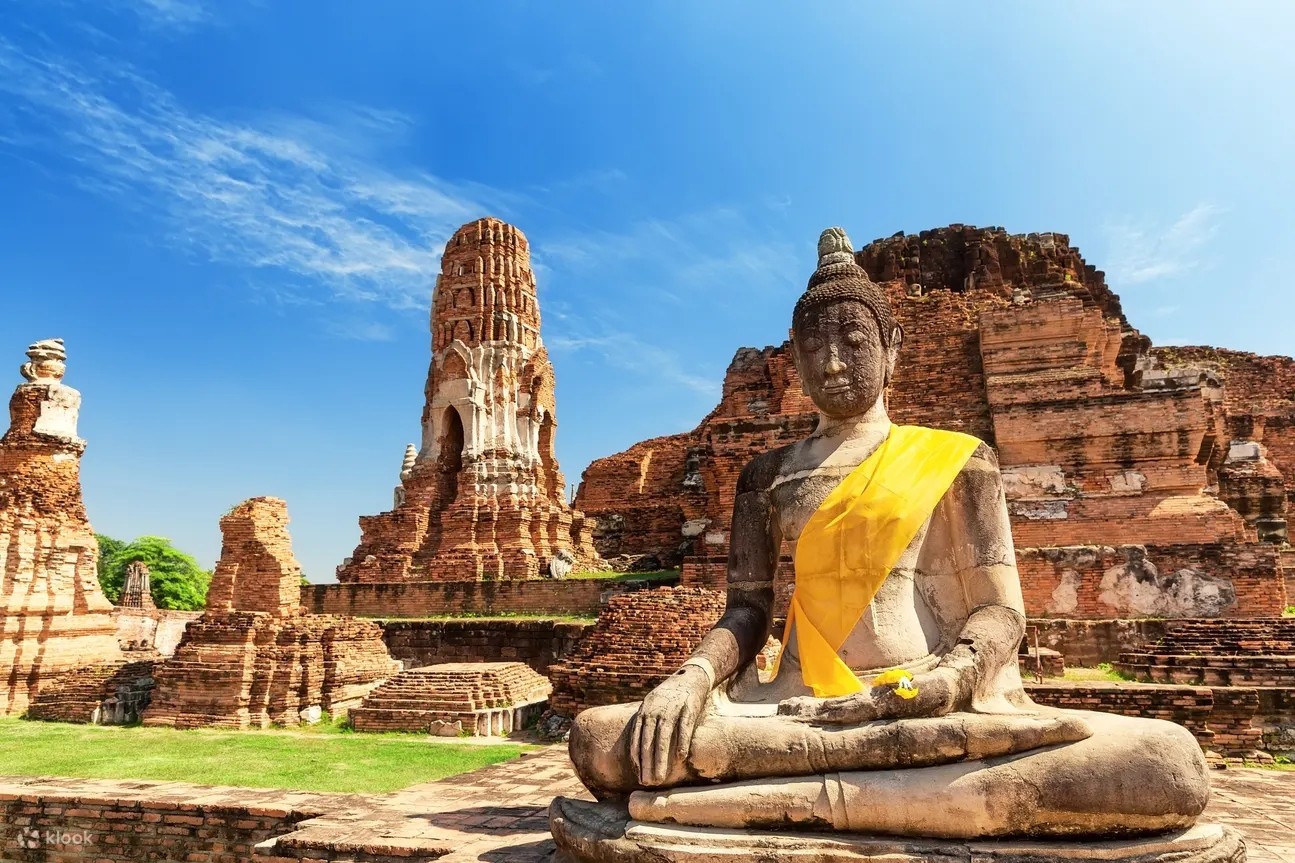
Ayutthaya Historical Park is a UNESCO World Heritage site located in the city of Ayutthaya, approximately 80 kilometers north of Bangkok. Established in 1351, Ayutthaya served as the capital of the Kingdom of Siam for over 400 years, flourishing as a major center of global diplomacy and commerce. The park encompasses the ruins of temples, palaces, and statues that reflect the grandeur of this ancient civilization.
Key Highlights:
- Wat Mahathat: This temple is renowned for the iconic Buddha head entwined in the roots of a banyan tree, making it one of the most photographed sites in the park.
- Wat Phra Si Sanphet: Once the holiest temple on the site of the old Royal Palace, it features three large chedis (stupas) that are prominent landmarks.
- Wat Yai Chaya Mongkhon: Known for its large reclining Buddha statue and rows of chedis, this temple offers a glimpse into the grandeur of Ayutthaya's past.
- Chao Sam Phraya National Museum: Located within the park, this museum houses artifacts from the Ayutthaya period, including gold jewelry, ceramics, and religious artifacts.
Visiting Information:
- Operating Hours: The park is open daily from 8:00 AM to 6:00 PM.
- Admission Fees: A combined ticket for six major temples within the park costs 220 Thai Baht. Individual temple entry fees may vary.
- Transportation: Ayutthaya is accessible from Bangkok by train, bus, or private car. Within the park, visitors can explore by walking, bicycle, or tuk-tuk.
Tips for Visitors:
- Dress Code: When visiting temples, it's respectful to dress modestly—covering shoulders and knees.
- Best Time to Visit: The cooler months from November to February are ideal for exploring the park.
- Guided Tours: Hiring a local guide can enhance your experience by providing historical context and insights into the significance of the sites.
09. Wat Arun (Bangkok’s Oldest Temple):
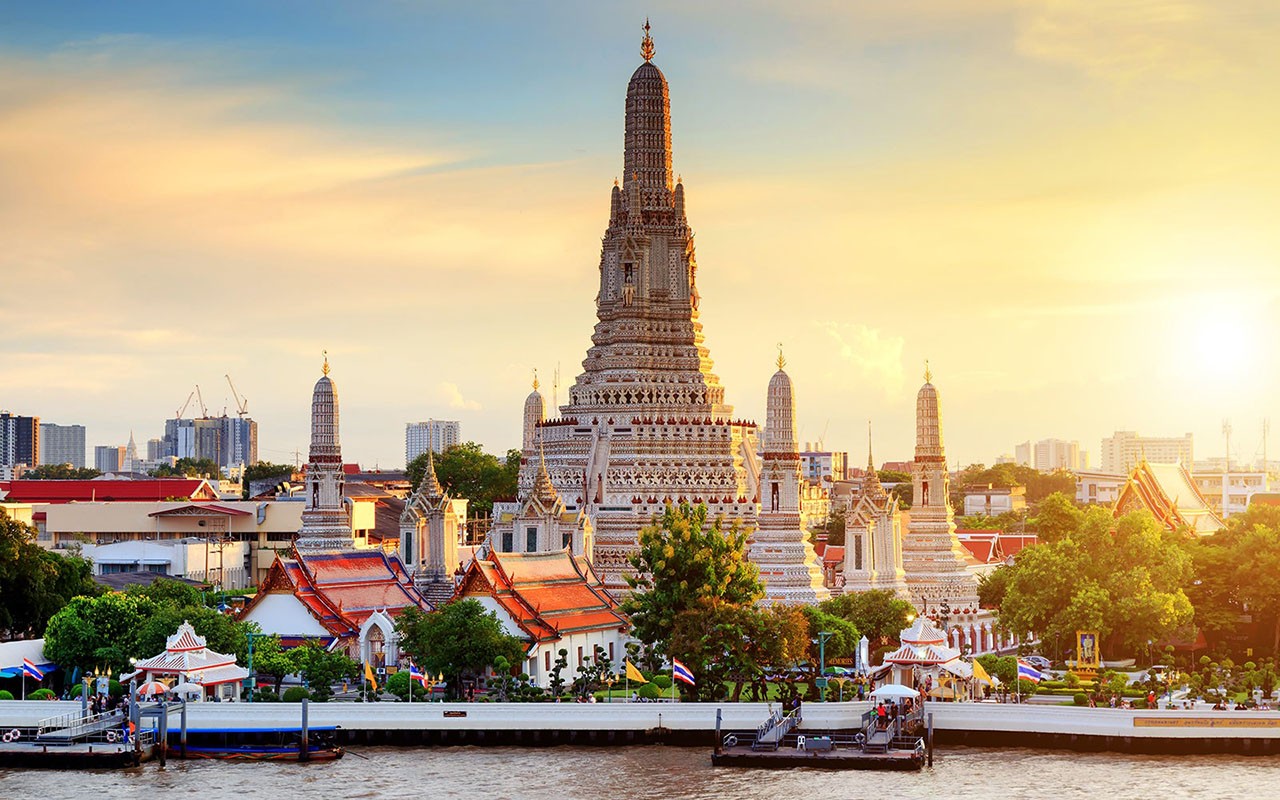
Wat Arun, also known as the Temple of Dawn, is one of Bangkok's most iconic landmarks, situated on the western bank of the Chao Phraya River. Its central spire, or prang, stands approximately 82 meters tall and is adorned with intricate porcelain and seashell decorations, reflecting a blend of Khmer and Thai architectural styles.
Historical Significance:
The temple's name, "Wat Arun," is derived from the Hindu god Aruna, symbolizing the radiations of the rising sun. It is believed that King Taksin arrived at the site at dawn in 1767, leading to its association with the morning sun.
Visiting Information:
- Operating Hours: Daily from 8:00 AM to 6:00 PM.
- Admission Fee: 50 Thai Baht.
- Location: Thonburi district, Bangkok, Thailand.
Visitor Tips:
- Dress Code: Modest attire is required; shoulders and knees should be covered when visiting the temple.
- Best Time to Visit: Early morning or late afternoon to avoid crowds and experience cooler temperatures.
- Access: Accessible via ferry from Tha Tien Pier on the opposite bank of the river.
10. Dusit Palace:
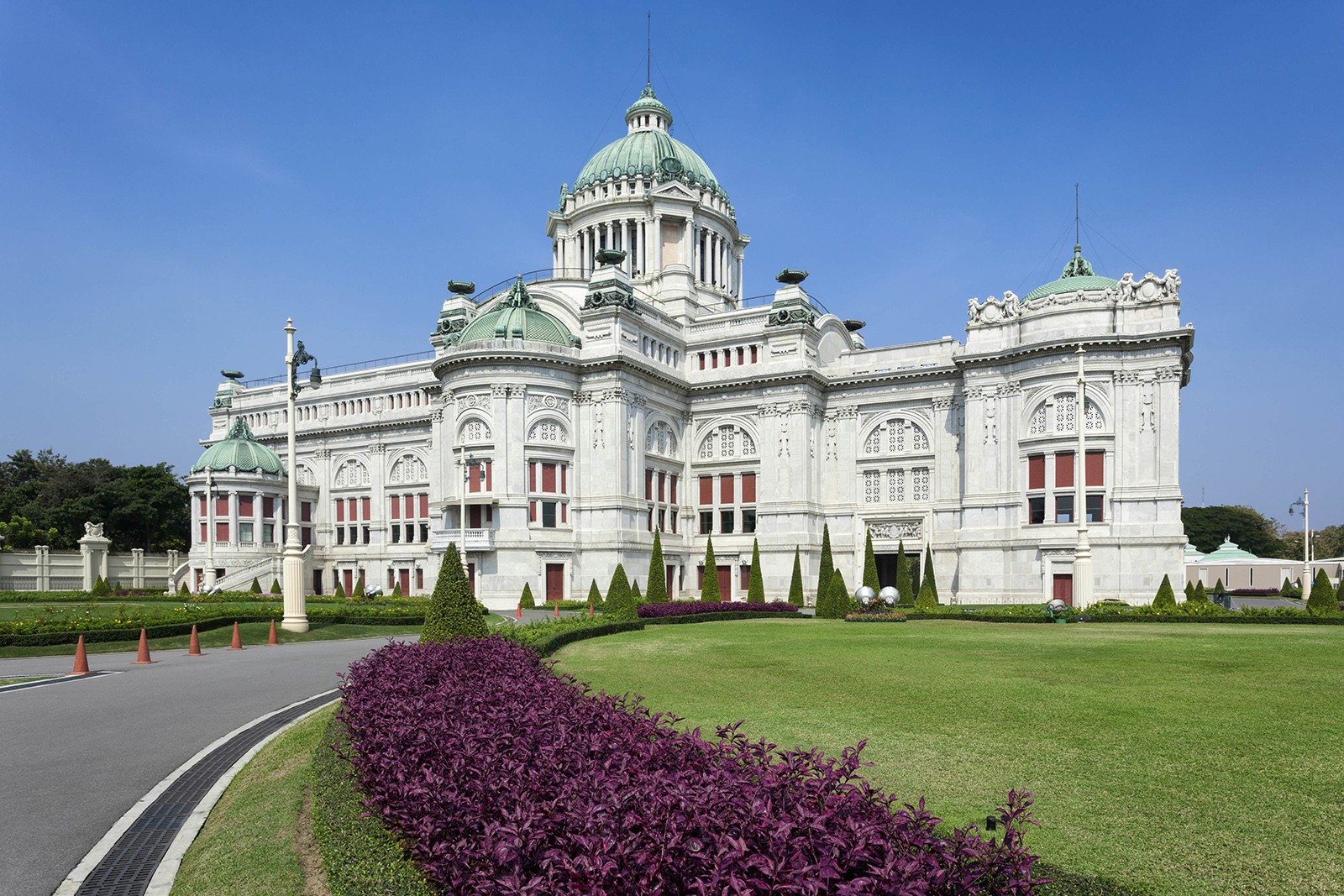
Dusit Palace, located in Bangkok's Dusit district, is a significant historical complex that reflects the grandeur of Thailand's royal heritage. Constructed between 1897 and 1901 by King Chulalongkorn (Rama V), the palace was designed to emulate European architectural styles, showcasing a blend of Western and traditional Thai elements.
Key Highlights:
- Vimanmek Mansion: This hexagonal-roofed teak mansion, believed to be the world's largest teakwood building, served as King Rama V's residence in the early 20th century. Visitors can explore its opulent interiors, which house a collection of royal memorabilia and early Rattanakosin-era art.
- Ananta Samakhom Throne Hall: Modeled after the Italian Renaissance style, this grand hall was once used for royal ceremonies and is now a museum showcasing Thai art and culture.
- Abhisek Dusit Throne Hall: Constructed in the early 20th century, this hall is known for its unique architecture and serves as a venue for royal ceremonies.
Visiting Information:
- Operating Hours: The palace complex is typically open daily from 9:00 AM to 4:00 PM. However, hours may vary, so it's advisable to check the official website or contact the palace directly before planning your visit.
- Admission Fees: Entry fees vary depending on the specific buildings and exhibitions you wish to visit. For instance, the Vimanmek Mansion charges an entry fee of 100 Thai Baht.
- Dress Code: Visitors are required to dress modestly when visiting the palace. This includes covering shoulders and knees.
Transportation:
- By Ferry: Take the Chao Phraya Express Boat to Thewet Pier. From there, it's approximately a 20-minute walk to the palace.
- By Skytrain: Board the Skytrain at Phaya Thai BTS Station. From there, the palace is about a 3 km walk towards the east.
Best Time to Visit Bangkok:
For many people, the best time to visit Bangkok is the rainy season. During this time, the city is much more pleasant, as there aren't as many tourists and it is also easier to get around. If you are planning a visit during the rainy season, be sure to bring an umbrella or a raincoat. You may also want to dress in layers, as temperatures can drop quickly.
The other good time to visit Bangkok is during the cool season. This is when central Bangkok gets much cooler than the surrounding areas. This can be great for those who want to escape the heat of the summer months, but still want to be close to central Bangkok. Also, This is a good time for cultural events like art festivals and parades.
The best time of year to visit Bangkok depends on what you're looking for. If you're looking for a relaxing vacation in a beautiful city, then the rainy season is your best bet! If you're looking for a culturally vibrant city that's ideal for both sightseeing and shopping, then you should try visiting during the cool season.
How to Get Around Bangkok:
Bangkok is a bustling metropolis with a lot of people, so it's not surprising that transportation is an issue. Luckily, there are so many options for getting around the city. The easiest option is to take a taxi. Taxis are plentiful and cheap—just remember to bargain for the price before you get in the car!
If you don't want to pay for taxis, there are also public buses and trains that will get you from A to B. The bus system is easy to navigate, but it can be slow if there are many people on board. The train system has more stops than the bus system, but it takes longer to travel between stops because they're spaced farther apart (about 25 minutes by train).
To avoid traffic jams or crowds at all times of day or night, consider purchasing an e-bike or motorcycle helmet instead! They're easy to use and provide plenty of protection for your head when riding on busy roads or sidewalks during rush hour traffic times.
Where to Stay in Bangkok:
Where to stay in Bangkok is a question that comes up often, and the answer is actually quite simple. There are plenty of hotels, hostels, apartments, guest houses and breakfasts in Bangkok that cater to all kinds of travelers. Bangkok has a variety of accommodation options available for travelers who want to stay in the city center. Sukhumvit Road is home to many expensive places, but there are also many other options close by. To find accommodations near your favorite destinations like, Patpong Night Market or Khao San Road, check out bookingMentor™ listings for hotels near those areas.
Bangkok Budget and Money-Saving Tips:
Planning a budget as a traveler in Bangkok is not as difficult as you may think. The following tips will help you get started with your budget planning.
- Have a detailed list of the things you bring with you and the things that you need to buy or rent when you arrive in Bangkok.
- Calculate how much money you have left after all expenses are covered, including housing costs and entertainment expenses (if any).
- Figure out how much money you need for emergencies such as transportation breakdowns or medical expenses.
- Don't forget to include small purchases such as eating out, shopping at markets and souvenirs while traveling in Thailand!
- You can save money by buying in bulk when possible and using coupons whenever possible.
- Make sure that you are paying for any purchases (food, drinks) using only cash and not credit cards—which can lead to unnecessary fees and charges later on down the line!
- If you're going with friends or family members, then consider renting out a room in Bangkok.
Bangkok offers an amazing mix of history and heritage that attracts travelers worldwide. From the stunning Grand Palace to the peaceful Wat Pho and the lively markets of Chinatown, the city is full of cultural gems. Exploring these places lets you dive into Thailand's rich past, experiencing ancient traditions and beautiful architecture. Whether you're marveling at old temples or trying local food, Bangkok guarantees an unforgettable journey through Thai culture. So, pack your bags, start your adventure, and let Bangkok's history and heritage embrace you.
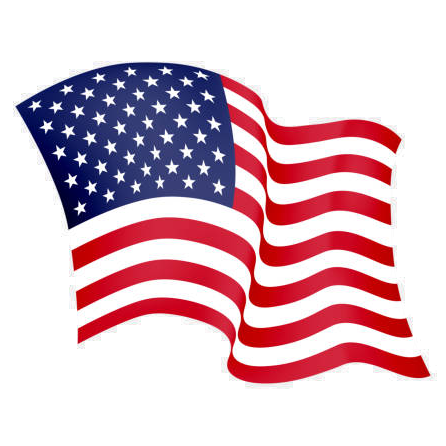


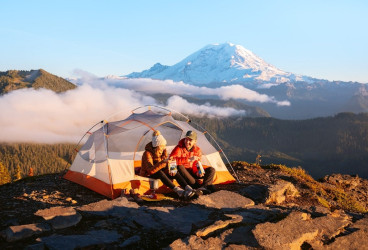
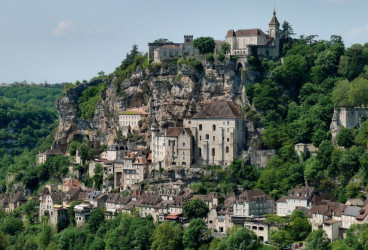







{{item.get_author.first_name}} {{item.get_author.last_name}}
Level 7
5 Photos
36 Reviews
{{item.comment_txt}}
{{item_reply.get_author.first_name}} {{item_reply.get_author.last_name}}
@ {{item_reply.reply_to}}, {{item_reply.reply_txt}}